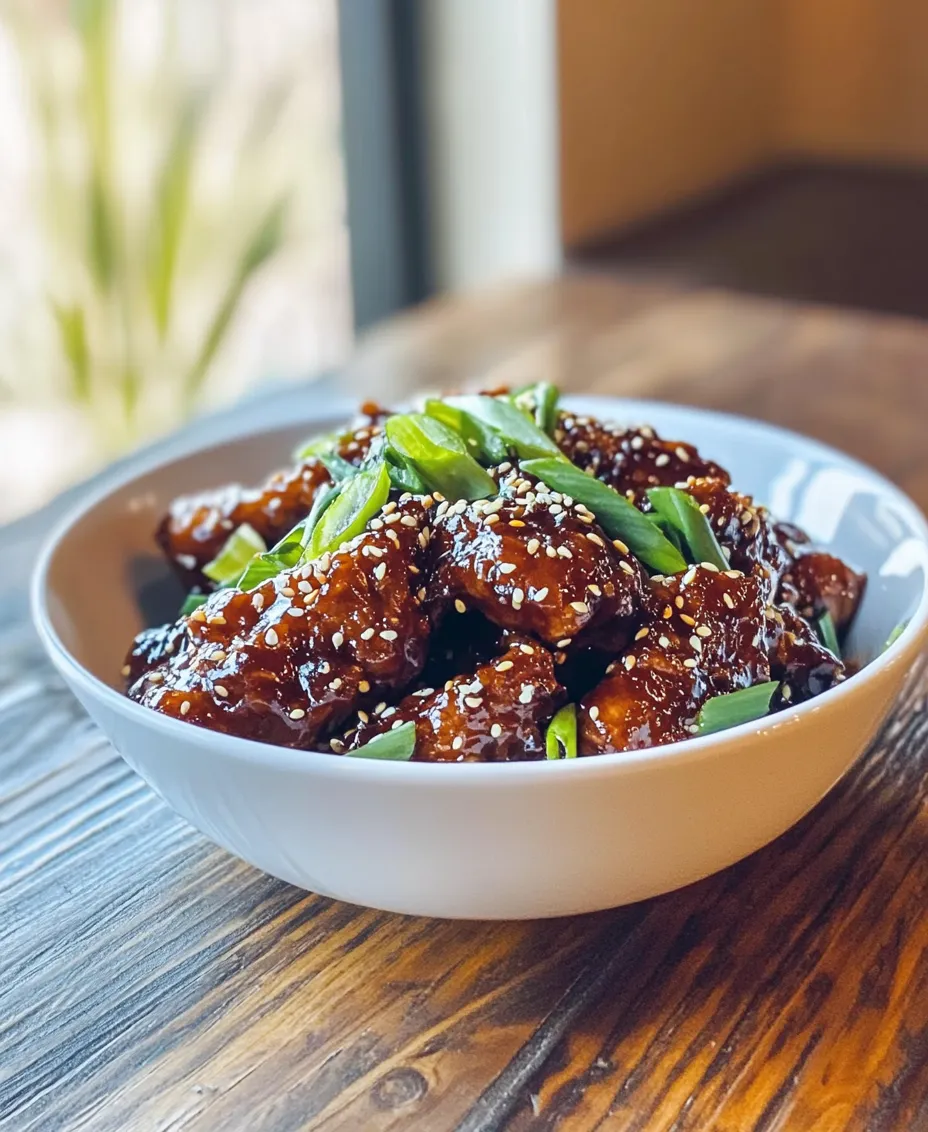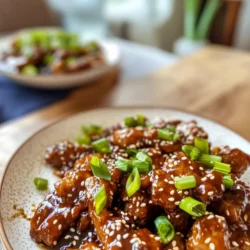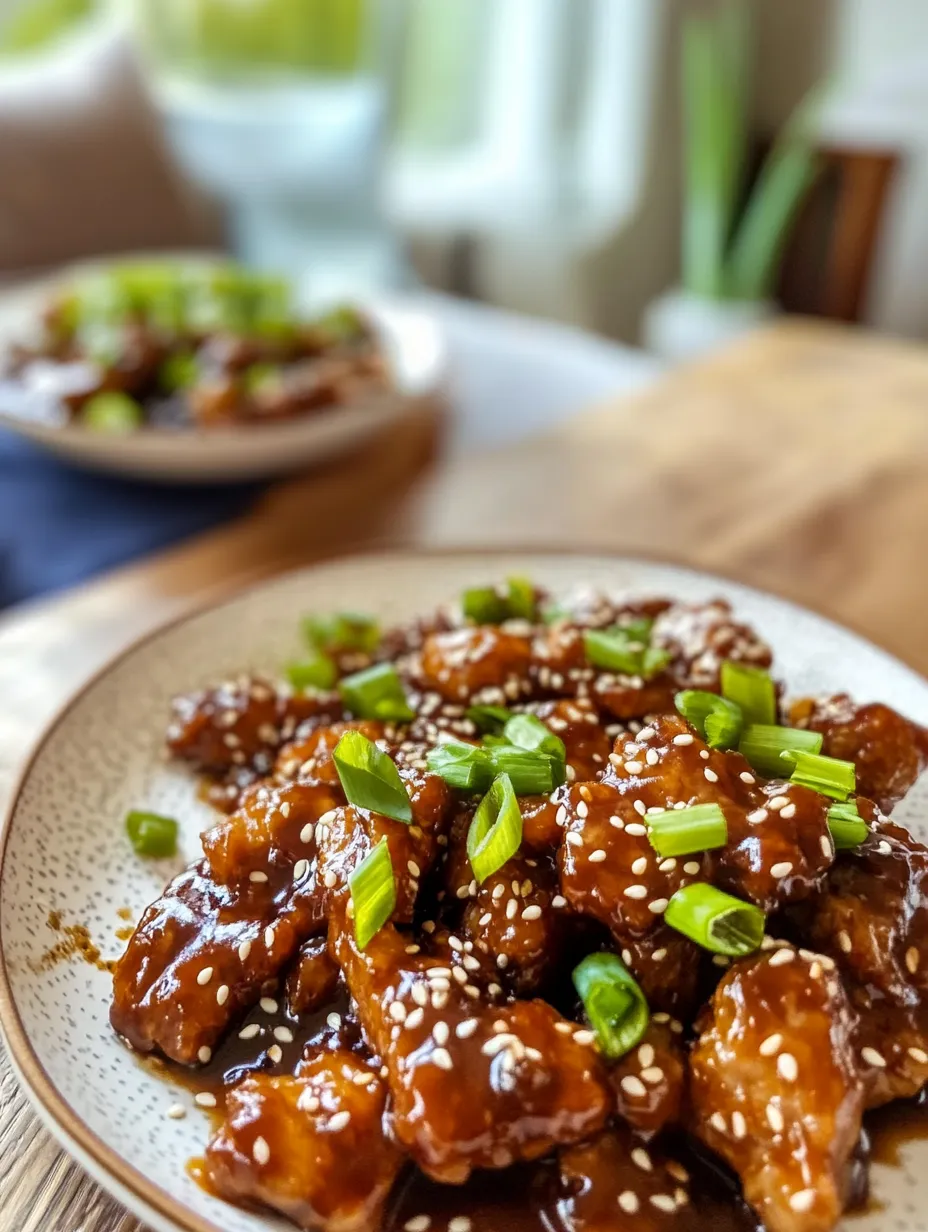Introduction
Mongolian Beef is a beloved dish that has found its way into the hearts and homes of food enthusiasts around the globe. While the name may suggest a deep-rooted connection to Mongolia, the dish is actually a creation of Chinese-American cuisine, often featured prominently in Chinese takeout menus. This savory stir-fry showcases tender strips of beef, enveloped in a glossy, sweet, and tangy sauce, making it a popular choice for those looking to indulge in the flavors of Asian cuisine without stepping out of their homes.
What makes this Easy Sticky Crispy Mongolian Beef recipe particularly appealing is its simplicity and the delightful balance of flavors and textures it brings to the table. With its crispy coating, tender beef, and rich sauce, this dish is sure to impress both family and friends, whether you’re whipping it up for a casual weeknight dinner or serving it at a special occasion. The combination of umami, sweetness, and a hint of acidity provides a taste explosion that will have everyone asking for seconds.
In this recipe, we will guide you through creating a dish that is not only delicious but also surprisingly easy to prepare. You will learn how to achieve that perfect crispy texture, infuse the beef with flavorful marinades, and craft a sauce that holds the key to this dish’s signature taste. So, roll up your sleeves and get ready to delight your taste buds with this Easy Sticky Crispy Mongolian Beef!
Understanding the Ingredients
To create a stunning plate of Mongolian Beef, it’s essential to understand the key ingredients that come together in this dish. Each component plays a significant role in contributing to the overall taste and texture, so let’s take a closer look at what you’ll need.
Flank Steak
The star of the show in our Mongolian Beef recipe is undoubtedly the flank steak. This cut of beef is known for its rich flavor and fibrous texture, making it ideal for stir-frying. Flank steak is relatively lean, which means it can become tough if not cooked properly. However, when sliced thinly against the grain, it transforms into tender, juicy morsels that soak up flavors beautifully. The key to achieving the best results is to ensure that you cut the beef thinly, as this allows for quick cooking and tender bites.
Cornstarch
Another crucial ingredient in this recipe is cornstarch. While it may seem like a simple pantry staple, cornstarch plays a pivotal role in achieving that desirable crispy coating on the beef. When coated in cornstarch and then pan-fried, the beef develops a crunchy exterior that contrasts beautifully with the tender meat inside. This technique not only enhances the texture but also helps the sauce cling to the beef, creating a more flavorful experience.
Sauce Ingredients
The heart of Mongolian Beef lies in its sauce, which is a delightful medley of flavors that coats the beef and adds depth to the dish. Here’s a breakdown of the key sauce ingredients:
– Soy Sauce: The backbone of the sauce, soy sauce provides a rich umami flavor and saltiness that is essential for balancing the dish. It enhances the savory notes and complements the sweetness from other ingredients.
– Brown Sugar: This ingredient introduces sweetness to the dish, which is vital for creating that signature sticky sauce. As the brown sugar caramelizes during cooking, it adds a rich flavor that deepens the overall taste experience.
– Rice Vinegar: To achieve a balanced flavor profile, rice vinegar is included for its acidity. This helps cut through the richness of the sauce and adds a refreshing tang that brightens the dish.
– Hoisin Sauce: A touch of hoisin sauce brings an additional layer of sweetness and complexity to the sauce. It has a unique flavor that combines elements of sweet, salty, and savory, enhancing the overall taste of the dish.
– Sesame Oil: Just a drizzle of sesame oil at the end of cooking adds a nutty aroma and flavor that elevates the dish to new heights. It’s a small but mighty ingredient that ties everything together.
– Chili Paste (Optional): For those who enjoy a bit of heat, chili paste can be added to the sauce. It provides a spicy kick that contrasts nicely with the sweetness and enriches the flavor profile, making it a versatile option for customizing the dish to your liking.
By understanding the role of each ingredient, you can appreciate how they come together to create the delightful experience that is Mongolian Beef. Now that we’ve covered the essential components, let’s move on to the preparation steps that will guide you through creating this dish.
Preparation Steps Explained
Creating the perfect Easy Sticky Crispy Mongolian Beef starts with proper preparation. The following steps will ensure that your dish turns out flavorful and texturally ideal. Let’s dive into the details.
Preparing the Beef
The first step in preparing your Mongolian Beef is selecting and slicing the flank steak. Begin by purchasing a high-quality flank steak, ideally around 1 to 1.5 pounds. Once you have your steak, it’s crucial to slice it correctly to achieve tender results.
1. Trim the Fat: If your flank steak has any visible fat, use a sharp knife to trim it away. Although a little fat can add flavor, too much will render your dish greasy.
2. Chill the Steak: For easier slicing, consider placing the flank steak in the freezer for about 30 minutes. This firming up of the meat will make it significantly easier to cut into thin strips.
3. Slice Against the Grain: Lay the flank steak on a cutting board and identify the direction of the grain (the lines running through the meat). Using a sharp knife, slice the steak against the grain into thin strips, about 1/4 inch thick. This is essential because slicing against the grain shortens the muscle fibers, leading to a more tender bite.
Once you’ve sliced the beef, place it in a mixing bowl and season it with a pinch of salt and pepper. Then, sprinkle cornstarch over the beef, ensuring each piece is well-coated. This will not only help develop a crispy exterior when cooked but will also create a barrier that locks in moisture, keeping your beef juicy.
Marinating the Beef
To enhance the flavor of the beef before cooking, you can create a quick marinade. In a separate bowl, combine soy sauce, a dash of sesame oil, and a teaspoon of rice vinegar. Mix well and pour this marinade over the beef strips. Allow the beef to marinate for at least 15 to 30 minutes at room temperature. This step is crucial, as it allows the flavors to penetrate the meat, resulting in a more delicious final dish.
With the beef marinated and ready, you’re well on your way to creating a delightful Mongolian Beef dish that showcases a perfect blend of flavors and textures. Next, we’ll discuss the cooking process, where the magic truly happens, bringing this dish to life.
Stay tuned for the next part of our journey into the world of Easy Sticky Crispy Mongolian Beef, where we will delve into the cooking techniques and tips that will take your dish from good to absolutely unforgettable.

Coating the Beef with Cornstarch: Tips for Achieving the Perfect Crisp
To achieve the coveted crispy texture in your Mongolian beef, the first and crucial step is coating the beef slices in cornstarch. This method not only enhances the texture but also helps to lock in moisture, allowing for a tender bite amidst the crunch. Begin by slicing your beef into thin strips, ideally around ¼ inch thick, and place them in a mixing bowl. Sprinkle a generous amount of cornstarch over the beef and toss it gently to ensure that each piece is evenly coated.
One key tip to achieving the ideal crisp is to allow the coated beef to rest for about 10-15 minutes before cooking. This resting period allows the cornstarch to adhere firmly to the meat and creates a drier surface that will fry better. When you’re ready to cook, shake off any excess cornstarch to avoid clumping in the pan. The result will be beautifully crisp beef strips that are a highlight of your dish.
Making the Sauce: Importance of Combining Ingredients for Flavor Infusion
The sauce is the heart of Mongolian beef, and mastering it is essential for a successful dish. To create the perfect sauce, combine soy sauce, brown sugar, garlic, ginger, and a touch of sesame oil in a bowl. The soy sauce brings the umami flavor, while the brown sugar balances it with sweetness, creating that irresistible sticky glaze.
Mix these ingredients thoroughly until the sugar dissolves completely—this step is crucial as it allows for a uniform distribution of flavors. For added depth, consider incorporating some red pepper flakes or chili oil at this stage if you prefer a bit of heat. Once your sauce is prepared, set it aside, as you’ll want to add it to the beef after frying for that burst of flavor infusion.
The Frying Process: Explanation of Oil Temperature and Frying Technique
Now, onto the frying process. The right oil temperature is key to achieving perfectly crispy beef. Heat a large skillet or wok over medium-high heat and add a suitable amount of vegetable oil—enough to create a shallow layer for frying. To test if the oil is hot enough, drop a small piece of coated beef into the pan; if it sizzles immediately, you’re ready to go.
When frying the beef, work in batches to avoid overcrowding the skillet. Overcrowding can lower the oil temperature, leading to soggy beef instead of crispy. Allow each batch to fry for about 2-3 minutes, flipping them halfway through to ensure even cooking. The goal is to achieve a golden-brown color, which indicates that the beef is cooked through and crispy.
Importance of Not Overcrowding the Skillet
As mentioned, avoiding overcrowding is essential. When too many beef slices are added to the skillet at once, they can stick together, steam instead of fry, and ultimately lose that desirable crispiness. To maintain the ideal frying conditions, cook in batches, ensuring there’s ample space for each piece to fry freely. This not only promotes even cooking but also prevents the temperature drop that can occur when you add too much meat to the pan at once.
Cooking Techniques for Perfect Mongolian Beef
Ideal Cooking Temperature and Timing for Frying the Beef
To get that perfect crispy texture, it’s important to maintain a consistent oil temperature. Ideally, the oil should be heated to around 350°F (175°C) before you start frying the beef. This temperature allows the cornstarch to fry quickly, creating a crunchy exterior while keeping the inside juicy.
Fry each batch for about 2-3 minutes, watching for the color change. The beef should be golden brown and crispy on the outside. Use a slotted spoon to remove the beef from the oil and transfer it to a plate lined with paper towels to absorb any excess oil.
How to Tell When the Beef is Perfectly Crispy and Golden Brown
Knowing when your beef is perfectly cooked is crucial. Look for a deep golden-brown color, which indicates that the outside has caramelized slightly, creating that crunchy texture. Additionally, the beef should feel firm to the touch but still give slightly when pressed. If the beef is browning too quickly, lower the temperature to avoid burning.
Tips for Simmering the Sauce to Achieve the Right Consistency
Once all the beef is fried, it’s time to bring everything together. In the same skillet, pour in your prepared sauce and bring it to a gentle simmer over medium heat. As it heats up, the sugar will begin to dissolve and the flavors will meld beautifully. Allow the sauce to simmer for about 2-3 minutes to thicken slightly; you can tell it’s ready when it coats the back of a spoon.
Toss the crispy beef in the sauce, ensuring each piece is evenly coated. This process not only flavors the beef but also allows the cornstarch exterior to absorb some of the sauce, enhancing the dish’s overall texture.
Importance of Tossing the Beef in the Sauce for Even Coating
Tossing the beef in the sauce is not merely a decorative step; it’s essential for flavor distribution. Ensure that the beef is coated evenly, using a spatula or tongs to gently stir the beef into the sauce. This step allows the sticky sauce to cling to the beef, providing that signature Mongolian beef flavor in every bite.
Serving Suggestions
Best Practices for Serving Mongolian Beef
Once your Easy Sticky Crispy Mongolian Beef is ready, it’s time to plate it. Serve the beef hot over a bed of steamed white rice, fried rice, or even lo mein noodles. The warm, fluffy base will soak up the delicious sauce and complement the crispy beef perfectly.
Suggested Side Dishes: Steamed Rice, Fried Rice, or Noodles
Pairing your Mongolian beef with the right side dishes can elevate your meal. Steamed jasmine rice is a classic choice, as its subtle flavor enhances the richness of the beef. Fried rice, with its savory elements and vegetables, adds a delightful contrast. Alternatively, serve it over noodles for a heartier meal. Each option brings its unique texture and flavor that harmonizes with the dish.
Ideas for Garnishing: Additional Green Onions and Sesame Seeds
To finish off your dish, add a sprinkle of freshly chopped green onions and a handful of sesame seeds. These garnishes not only add a pop of color but also enhance the flavor profile. The green onions provide a fresh crunch, while the sesame seeds offer a nutty finish.
Nutritional Information
Breakdown of the Nutritional Value per Serving
Understanding the nutritional value of your Easy Sticky Crispy Mongolian Beef can help you appreciate the health aspects of your meal. A typical serving contains about 350-400 calories, depending on the amount of sauce used and the type of sides you choose.
Discussion on Calorie Content, Protein, and Other Macronutrients
This dish is relatively high in protein, thanks to the beef, providing about 25-30 grams per serving. It also contains carbohydrates primarily from the sauce and any accompanying rice or noodles. While it’s best enjoyed as an occasional treat due to its higher sugar content from the sauce, you can easily modify portions to fit into a balanced diet.
Overview of How This Dish Fits into a Balanced Diet
Mongolian beef can be part of a balanced diet when enjoyed in moderation. Pairing it with colorful vegetables—like bell peppers, broccoli, or snap peas—can increase fiber and nutrient intake. Additionally, serving it with whole grains, such as brown rice, can enhance its nutritional profile.
Conclusion
The Easy Sticky Crispy Mongolian Beef recipe is a delightful combination of flavors and textures that can easily become a family favorite. The steps involved may seem intricate, but with the right techniques, you can achieve restaurant-quality results at home.
Don’t hesitate to experiment with the recipe by adding your personal touch—perhaps some vegetables for added nutrition or adjusting the spice levels to suit your taste. Homemade Asian cuisine is not just about satisfying hunger; it’s about bringing people together around the table to share in the joys of cooking and eating. Enjoy crafting your dish, and savor the experience of sharing it with loved ones.


